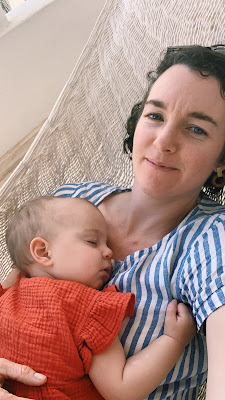The Poetry of Lullabies
I had a wonderful conversation with a fellow poet, Melanie Weldon-Soiset, yesterday. We are both poetry students in the low-residency Spalding University MFA program. She spoke to me about her work and research into lullaby poems, which, as a lover of meter and music, I find fascinating.
I've always been drawn to lullabies. There's a brief scene in "Paris, je t'aime" where actor Catalino Sandino Moreno sings the Spanish lullaby "que linda manito" to a baby. When I watched this film in college, I rewound the DVD to listen again and again until it was stuck in my head (I found the audio of that scene here!). Lullabies often have perfect meter and a melodic resolution, and I think a body craves this. Meter and melody make sense to us on a cellular level. So even a Spanish lullaby, which I did not understand when I first heard it, achieved its intended effect on me through those elements alone.Years later, when the first of my close friends had a baby, I recorded an album of Appalachian lullabies inspired by Moira Smiley, Anna & Elizabeth, and others, mixed it in ProTools (this was during my time working in radio!) and wrote the lyrics down for her in a book I bound myself. It was a sweet gift, and one I relished making.
I think the bigger thing I find fascinating about lullabies is not the effects of sound on the listener, but on the singers themselves. Lullabies are a whole genre of music that women have passed down generationally and communally for centuries. The existence of the genre speaks to the importance of child-care work, the extreme patience required from caregivers, and most of all the beautiful creativity that women bring and have brought to this work---not just in caring for their own children, but especially for African-American women in the US, in caring for other people's children. This work is long, tedious, and isolating, and I think it's important to acknowledge that for many women performing this work, it was (and still is) not a choice.
Melanie shared a link with me to the Lomax Digital Archive section on lullabies, which documents the voices of women singing lullabies across many cultures: American, Haitian, Italian, Dominican, and more. On that page, singer Samoa Wilson says, "I think of lullabies as forming a sort of traceable matriarchal lineage," which is a powerful way to think of it. Lullabies are an oral tradition that is still widely practiced, information stored in our bodies that we can recall instantly.
There are many other parts of lullaby that I find intriguing, and I'd love to continue mining this thread in writing and conversation. What associations do you have with lullabies?
If you are curious to learn more about Melanie and her work, I encourage you to sign up for her newsletter here!



Comments
Post a Comment